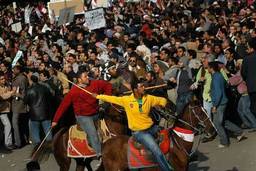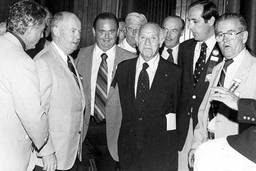Mary Ellen Sachetti, a construction company safety executive, was working at the World Trade Center when the planes were flown into the towers on September 11, 2001. After 9/11, Sachetti helped plant the seeds that kept the rescue, recovery and deconstruction efforts at Ground Zero running efficiently and effectively. But she didn’t stop there. She came back every day until the project was completed nine months later. With her tough organizational mind and tender compassion, Sachetti became a buoy in an ocean of despair and chaos for many of the firefighters, police officers and construction workers at Ground Zero.
Here is Sachetti's account of 9/11.
—Ray Abernathy
We actually had a job at the site. We were doing the Vietnam Veteran’s Memorial Plaza. I was down there for a final inspection and it was a beautiful day. I remember that around nine o’clock or so I had gone inside and then all of a sudden I heard these people saying that a plane had hit. We weren’t really sure what was going on. I had stepped outside and all these papers were coming down all around us. We didn’t know. We couldn’t even fathom where the paper was coming from, and I said: “This is really serious.” By the time I walked back into the building I had gotten a call from my main office telling me that we were, that something was terribly wrong, and that I needed to evacuate our building.
As we were trying to get out the police started running and people started running, saying: “The building’s coming down, the building’s coming down.” We couldn’t imagine what building, and I’m thinking smaller building, and then they said: “The tower’s coming down.”
As we were going toward the water, people were fighting on the streets, trying to get into cars and drive away, and I had gotten caught up and knocked to the sidewalk. I got cut up a little bit. Thank God I was with two laborers. They really were my guardian angels that day. They pulled me up and kept saying: “We’ve got to get to the water.” We got to the water and the cloud began to overtake us. It was terrible. It was just terrible. And I remember hearing a jet or something coming in, and I thought, this is the only time I thought I was going to die. I said: “They are going to bomb us for sure. This is it.”
Everyone in the crowd had immediately crouched down by a concrete barrier by the FDR [Parkway]. The laborers’ said: “We’ve got to get out of here.” They hoisted me up over an eight-foot tall concrete barricade. I was cut, clawing to get up, and they got me up and over and we started to walk north up the FDR. Then we saw the other tower come down, and it was a sound I will never forget, and a sight, and just so quiet for a long time as you just kept walking.
[Mary Ellen kept walking to a Plaza Construction job site on 14th Street, then walked with a group of other employees to their headquarters office on 38th Street where, despite her ordeal, she started making plans to help with the volunteer effort.]
I stayed here very late that night and on the way home on the train, I saw World Trade Seven come down. The smoke had come up, and we heard on our little radios that the building had come down. I really didn’t cry or anything until I came home and saw my 11-year-old son on the front lawn, very concerned, and my husband. And I told them I had to go back. They were very concerned, but I said: “I will be safe. Don’t worry. I’ll take care of myself.” And I came back to New York City, organized a group of men at our offices here and we took safety vests, flags, glasses, goggles, respirators, whatever – shovels – anything, and we went down to the area of Chelsea Piers.
The men decided they were going to try and walk in, up the West Side Highway, and I said: “Let me go into Chelsea Piers and see what I can do.” When I got into Chelsea Piers, it was chaos. This was about seven in the morning, 7:30, just a lot of chaos. I put my name on a volunteer list, but I immediately began to see that they needed someone to help organize themselves. People were bringing down clothes, beginning to block exits to get out. Every bag of clothes that came in had to be searched two times by policemen. They didn’t know whether bombs or whatever would come in. With a committee of 12 citizens, one a lawyer, a doctor – you know, a lot of different people – we came together and made this little committee. About 8:30, nine o’clock, the construction workers started to come.
We had a few minutes before nine o’clock, and I walked across a big, like a garage area, to another area where they had the Mash units set up. I looked in there and it was almost as big as the flight deck of a ship, and they had a table, an IV pole set-up, doctors, surgicals, two people in scrubs. And this went on for row, and row, and row, and row, but there were no victims. Nobody was coming.
I turned around and I went back in and I decided that I would take charge, I would do something, and I have to say that all my years of experience, training with OSHA, training what to do, how to organize, really began to come into help, to click. The doctors were organized and they were given lists in an area. The construction workers were divided into a couple of different groups. First, what they needed foremost were the ironworkers and I can hear them coming in with their Stillson wrenches clanging. They were walking right up to me because I had my white hard hat on and it was like their buoy in the ocean, and they were: “What can we do? What can we do?” I would look at each person and I would say: “What is your trade?” And he may say: ‘Carpenter, but I’ll do search and rescue,’ and each carpenter, electrician, person that came in, they wanted to know when they were gonna go in. They just wanted to get out there and help.
This is anywhere between 10 and 11, and they are coming in droves. So our little committee broke up to get more volunteers, to organize them in a particular area. And then I had firemen coming; I had firemen from out of state. I had rescue dogs coming in. I had a veterinarian come in and [I had to] find a space for them. There had to be about 200 firemen. We put them up on the balcony level. And then there were donations of food, trucks, donations of water. Anheuser Busch brought in a whole truckload of bottled water. There were supplies, medical supplies, mental health people coming down. A group of people just came together and they decided to organize housing, temporary housing, for anybody, senior citizens. Some families thought that we were the morgue because of the ice-skating rumor that had gotten out. And to look in their faces, and to tell them that their loved ones were not here was very difficult.
The sun went down. It was getting to be the middle of the night and bicycle messengers began to come down, a whole pack of them. We had every group imaginable. They all wanted to come. Our young people began to come at night, and they wanted to do something. At about three in the morning, I stood back and said: “The seeds have been planted. It’s time to go and rest.” One of the workers that I was with, she, we went home and talked a bit before we got a couple of hours of sleep. Then we got up again and started all over the next day.
This post originally appeared at Ray Abernathy's blog, From the Left Bank of the Potomac.
Ray Abernathy has been a political, labor and public relations consultant for more than 40 years, working exclusively for labor unions and nonprofits. His blog, From the Left Bank of the Potomac, is at www.rayabernathy.com. He is co-author of The Inside Game: Winning With Worksite Strategies and author of A Practical Press Guide for Local Labor Unions.




